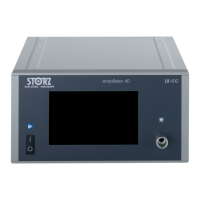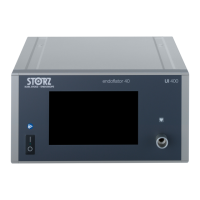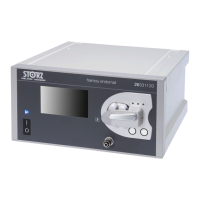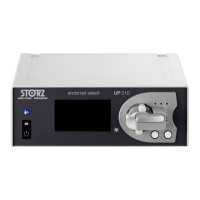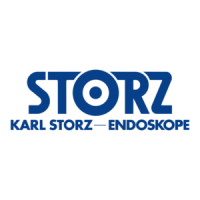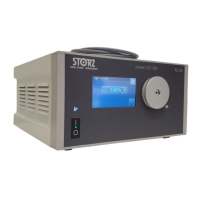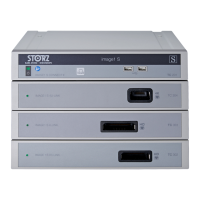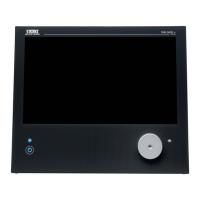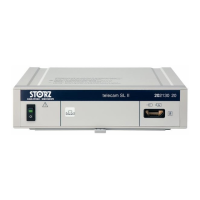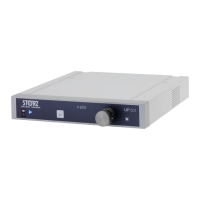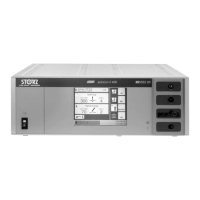Do you have a question about the Karl Storz ENDOFLATOR 50 and is the answer not in the manual?
Explains symbols found on the device itself.
Details symbols used on the device's user interface.
Describes symbols found on gas filter labels.
Provides a general description of the ENDOFLATOR® 50 device.
Details patent information and intellectual property rights.
Explains the meaning of warning, caution, and note symbols.
Outlines the intended purpose of CO2 insufflators and accessories.
Lists specific diagnostic and therapeutic interventions for insufflator use.
Lists situations where the insufflator's use is contraindicated.
Provides important warnings related to the device's operation.
Details warnings about excessive CO2 absorption and related issues.
Specific warnings for the PEDIATRICS MODE.
Warnings related to endoscopic vessel harvesting procedures.
Specifies the required qualifications for operating the ENDOFLATOR® 50.
Outlines the expected user profile and skills for medical professionals.
Specifies the intended environments for device usage.
Specifies the intended environments for device usage.
Lists other conditions related to frequency, duration, and mobility of use.
Describes the recommended user position for operation and observation.
Safety measures to be taken at the device's installation location.
Safety measures to be observed during device operation.
Details the device's safety mechanisms and monitoring functions.
Details the device's automatic self-test procedure.
Explains how the device monitors operation during use.
Instructions for unpacking the device and checking the delivery.
Lists the basic components included with the ENDOFLATOR® 50 set.
Instructions for setting up and connecting the device.
Details how to connect the potential equalization cable.
Instructions for connecting the power cord.
Instructions for connecting the KARL STORZ SCB cable.
Steps for optionally attaching the CO2 bottle holder and bottle.
How to connect the CO2 bottle to the device.
Connecting CO2 bottles with German or ISO connectors.
Connecting CO2 bottles with PIN-Index connectors.
Instructions for opening the CO2 bottle valve.
How to connect to the central gas supply.
Information regarding the initial setup and commissioning of the device.
Initial setup and configuration of the device.
Steps for normal operation after initial setup.
Describes how errors are displayed and handled.
Instructions on how to change device settings.
Steps to change language and other initial settings.
Accessing the service menu, which is password protected.
Adjusting volume for warnings and key tones.
Configuring the overpressure valve setting.
Explains the device's menu options.
How to call up, create, edit, and delete saved procedures.
Instructions for preheating CO2 gas for patient comfort.
Procedures for testing the device's proper function and leakproofness.
Steps to prepare for insufflation using manual or saved procedures.
Recommended settings for pediatric patients based on age and weight.
Recommended settings for endoscopic vessel harvesting.
Step-by-step guide to performing CO2 insufflation.
Explains the information displayed on the screen during operation.
Procedures for safely shutting down and disconnecting the device.
Detailed explanation of the procedure list functionality.
Steps to create and save new procedures.
Instructions for modifying existing saved procedures.
Steps to delete saved procedures from the list.
Details the device's configuration settings.
Accessing and information about the password-protected service menu.
Explanation of the system log for storing information and alarms.
Information on administering the device, including exporting logs and password changes.
Steps to export the system log data via USB.
How to select the unit for pressure measurement.
Setting the device's date and time.
Displays device serial number, operating hours, and software versions.
Step-by-step guide for replacing the device's fuses.
General warnings and procedures for reprocessing the device and accessories.
General safety warnings related to reprocessing medical devices.
Specific reprocessing instructions for the ENDOFLATOR® 50 unit.
Instructions for manual wipe-down disinfection.
Reprocessing instructions for disposable insufflation tubing sets.
Procedures for cleaning, disinfecting, and sterilizing reusable insufflation tubes.
Lists necessary accessories for reprocessing.
Steps for initial cleaning and disinfection preparation.
Instructions for manual pre-cleaning and disassembly of the device.
Detailed steps for manual cleaning of the device.
Detailed steps for manual disinfection of the device.
Procedures for machine cleaning and disinfection.
Assembly, inspection, and care of the reusable insufflation tube.
Specifies approved packaging materials and systems.
Instructions and warnings regarding sterilization of reusable components.
Information on the lifespan of components and when they need replacement.
Covers routine maintenance and safety checks.
Information on preventive maintenance and service.
Requirements for annual safety and repeat inspections per IEC 62353.
How to perform functional checks and document results.
Importance of documenting safety checks and results.
Guidelines for servicing and repairing defective equipment.
Procedures for proper disposal of the device as electronic waste.
Information on loaner devices during repair periods.
Crucial information regarding infection prevention and warranty.
Manufacturer's liability conditions for device safety and performance.
Details warranty conditions and procedures for sending the device for service.
Explains the device's alarm system and types of alarms.
Details the specific thresholds for overpressure alarms in different modes.
Explains the overpressure alarm mechanism and triggers.
Explains the CO2 empty alarm and its activation conditions.
Describes how alarms are visually indicated on the screen.
Details the specifications of the acoustic alarm signals.
Information on factory settings for alarm volume.
How to verify the alarm system's functionality.
Explains the device's information signals.
How information signals are visually displayed.
Details the acoustic information signal specifications.
Procedures for testing device alarms and information signals.
Steps to test the overpressure alarm.
Steps to test the CO2 empty alarm.
Steps to test information signals.
Troubleshooting guide for common device errors.
Technical specifications of the ENDOFLATOR® 50.
Compliance with electrical and safety standards.
Compliance with the Medical Device Directive (MDD).
Information on obtaining technical documentation from the manufacturer.
List of spare parts and recommended accessories with article numbers.
Lists available accessories for the device, including part numbers.
General information and warnings regarding electromagnetic compatibility (EMC).
| Brand | Karl Storz |
|---|---|
| Model | ENDOFLATOR 50 |
| Category | Medical Equipment |
| Language | English |
